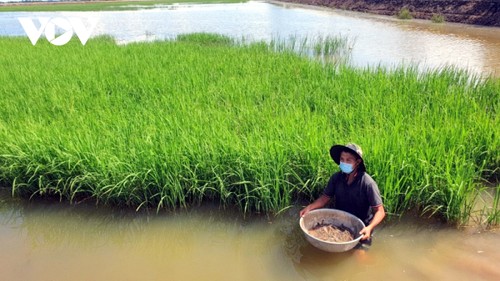 Raising linh fish has become a sustainable livelihood model during the flooding season in the Mekong Delta region. Raising linh fish has become a sustainable livelihood model during the flooding season in the Mekong Delta region. |
Rather than spread nets or place bamboo baskets to catch fish and shrimp as they did in the past when the Mekong River floods came, Dong Thap farmers have raised linh fish (a fish that thrives in parts of Southeast Asia), snakehead fish, and giant freshwater prawns in their paddy fields, boosting their annual income by thousands of dollars.
Bui Chi Nhan, a Dong Thap resident, told VOV that he can harvest 2 tons of linh fish from 220 USD worth of young breeding fish.
If he sells them for 5.8 USD per kilo, he will earn about 11,500 USD. That’s a profit from one month of raising linh fish, equal to two rice crops.
“The model is quite successful. I plan to expand the model and introduce it to other local farmers,” said Nhan.
In July, after harvesting the fish in his paddies, Nhan planted a rice crop using a variety whose growth is compatible with the rising water level.
One month later, Nhan released giant freshwater prawns from an adjacent pond into his paddy. The prawns eat organic materials in the paddy and grow well without any expensive industrial feed.
Nhan said if his yield of 5 to 6 tons of organic giant freshwater prawns sells for 6.6 USD per kilo, he will pocket between 33,000 and 40,000 USD.
He added, “This rice variety likes the high water levels suitable for shrimp farming. This model is all favorable.”
 Many Mekong Delta farmers raise linh fish and giant freshwater prawns in paddy fields. Many Mekong Delta farmers raise linh fish and giant freshwater prawns in paddy fields. |
Duong Phu Xuan, Head of the Economic Section of Hong Ngu city, says the rice-prawn model is a flood season model that benefits people in the upstream region of the Mekong River.
This is just the first crop, Xuan said. Next season, adjustments will be made to respond to new conditions.
New flood season models applied in upstream areas of Dong Thap like Hong Ngu have yielded revenues 220 to 1,600 USD per hectare higher than previous models.
“Hong Ngu city plans to build a community-based aquaculture model. After harvesting the summer-autumn rice, rather than leaving the land empty and waiting for the annual flood to clean the fields, farmers have taken the initiative in flooding the fields and bringing in aquatic resources. This feeds the aquatic resources, cleans the fields, and produces income from the aquatic resources that come from the community-based fish farming model,” said Xuan.
In recent years, due to a later rise of water levels, many farmers in the upstream areas of Dong Thap have changed from growing a third rice crop to doing aquaculture during the flood season, boosting their income 100 to 200% while protecting aquatic resources against climate change.